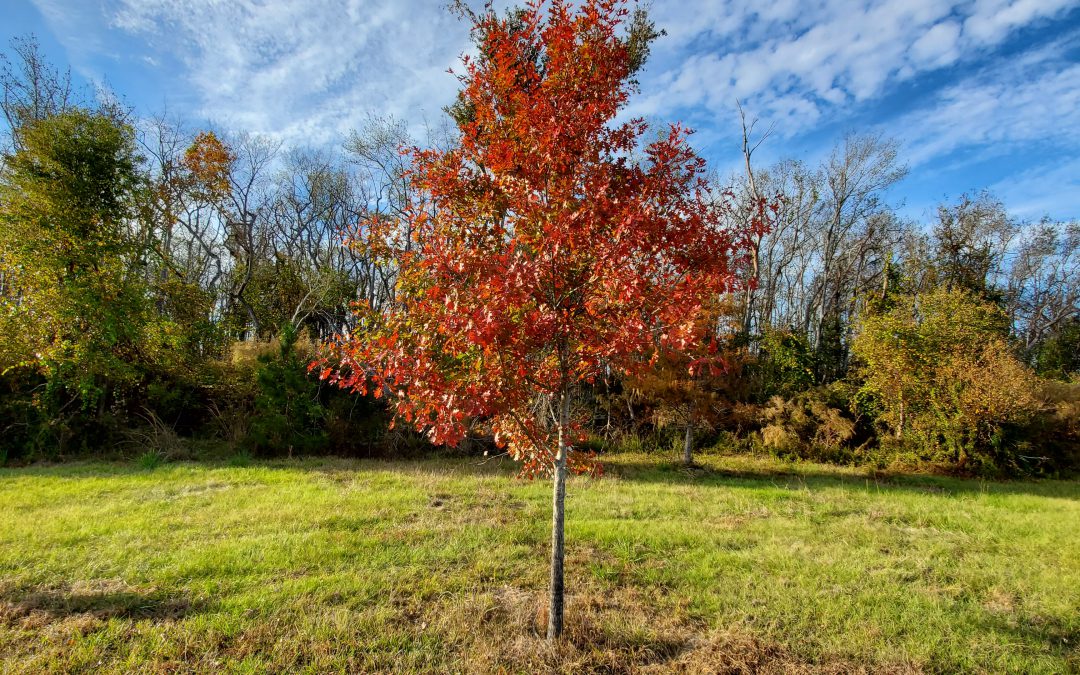
by Daniel J. Leonard | Jan 17, 2020
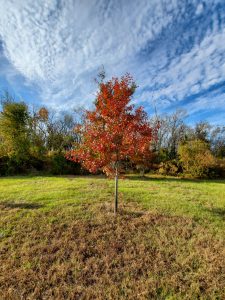
Five Year old Shumard Oak. Photo courtesy the author.
One of the keys to bagging a deer or mess of squirrels or just enjoying an afternoon viewing wildlife is to locate their preferred food source. In the Panhandle, this often means finding a natural stand of oaks or other mast producing trees. However, the concept of attracting animals to mast trees isn’t exclusive to natural areas; it can be replicated by hunters and wildlife enthusiasts to attract whitetail deer, squirrels, turkeys or any other game. (Don’t let the terminology confuse you, “mast” is just a term meaning “fruit from a tree”. “Hard” mast refers to nut producing trees -think Oak, Hickory, etc. Soft mast is just that, soft-fleshed fruits – think Pear, Plum, etc. This piece will focus on hard mast trees.) Regardless of semantics, the takeaway is that planting mast producing trees as winter wildlife attractants have several benefits.
- Enhanced habitat. Planting diverse groups of hard mast producing trees provides wonderful cover for deer to browse, squirrels to nest, and turkeys to roost. Also, groups of trees planted in open areas can help to create desired edge effects, see this publication on benefits of “edge” from Auburn University.
- Excellent nutritional supplement to winter food-plot forages (winter food plots are defined here as open areas planted in the cool season with small forage grains like oats, clover, or ryegrass). If a diversity of species is planted, hard mast trees are an excellent, season-long (approximately October-January) source of proteins and fats. They produce high-energy nutrients deer and other critters need to get through the winter months.
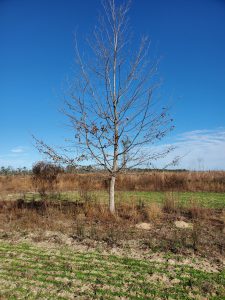
5 year old Sawtooth Oak in December 2019, inter-planted in winter forage plot. Photo courtesy the author.
- Reduction in time and money needing to be spent maintaining annual food plots. A well-designed grove of mast producing trees can be as effective in attracting deer and other animals as winter grazing plots and a whole lot cheaper. A study done by the University of Tennessee Extension in 2008 found that hunters spent about $200 per acre on winter food plots (seed, fertilizer, equipment, time, etc.), an expense that will happen EVERY year. And as many of you know from personal experience, $200 is a VERY conservative number, particularly if you value your personal time at all. Replacing half an acre of cultivated winter forage with mast trees will likely be more expensive in year one when you initially buy and plant but remember, if you do it right, you only have to do it once.
With those benefits of mast trees for wildlife attraction in mind, let’s address what and how to plant. Always select trees with desirable characteristics: long-lived, disease-free, and high-quality mast production at an early age (you don’t want your heirs to get all the benefit!). In the Panhandle, Oaks (Quercus spp.) fit this bill best. There are two groups of Oak to pick from, Red and White. Red Oaks generally have dark, ridged bark, leaves with pointed lobes, small to medium-sized acorns that mature in two seasons, and tend to crop reliably each year. White Oaks possess lighter colored bark, leaves with rounded lobes, large, “sweet” acorns maturing in one season, and tend to produce heavily in alternate years. Plant some of each group to ensure an acorn crop each year and maximize wildlife benefit! However, not just any old oak will do; the Oaks that most closely fit all the above characteristics are:
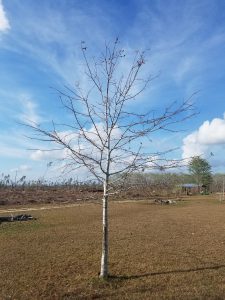
5 year old Nuttall Oak. Photo courtesy the author.
Nuttall Oak (Quercus nuttalli) – Red Oak Group. Rapidly growing, attractive tree, very early producer of good-sized acorns (5-6 years). Drops acorns late, providing needed fats and carbohydrates for bucks through much of the “rut” in the Panhandle (Late November-early February). Tolerates flooding and bottomland areas well.
White Oak (Quercus alba) – White Oak Group. Long-lived, stately tree. Relatively early producer of very large, sweet acorns. Acorn drop is earlier than Nuttall Oak. Grows best on moist upland soils.
Swamp Chestnut Oak (Quercus michauxii) – White Oak Group. Large tree with flaky white/gray bark. Relatively early producer of massive, prized acorns. Acorn drop occurs around the same time as White Oak. Prefers moist upland soils like its cousin the White Oak but will tolerate periodic flooding.
Sawtooth Oak (Quercus acutissima) – White Oak Group. Non-native. Medium-sized tree with heavy branches, often full to the ground. Very early and reliable producer of large, sweet acorns (begins producing at 5-6 years). Begins to drop acorns in September – often the first Oak to produce mast in the season. Grows best on moist upland soils.
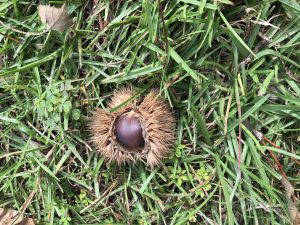
Chinese Chestnut mast in October. Photo courtesy the author.
Chinese Chestnut and Chinese/American Hybrids (Castanea spp.) – Not oaks but worthy of inclusion. Non-native or native hybrids. Medium-sized, spreading trees. Earliest producer of mast (3-4 years from seed germination). Highly sought-after by deer. Tolerates poor soils well but best production is in moist upland areas. I’m particularly partial to the newer American/Chinese Chestnut hybrids like ‘Dunstan’ and ‘AU Buck’.
It is important to remember that success starts at planting. Select healthy container or bare-root trees in the dormant season (December-February) and plant soon after to ensure the rootball doesn’t dry out. Dig planting hole the same depth plants are in containers or to depth of topmost root and backfill with native soil. Do not amend with compost or potting soil! After planting, the trees will need supplemental water, a few gallons per week, unless significant rainfall is received. Water regularly until establishment (when they no longer need your help, generally three-six months after planting).

4′ tree grow tubes are effective at protecting young trees from deer browsing. Photo courtesy the author.
Also, recently planted seedlings will need protection from deer browsing. Unfortunately, deer don’t realize these trees will directly benefit them in a few years and will do their best to destroy them by eating the tender new growth or “rubbing” with their antlers, girdling the trees in the process. I’ve found that either a small 4’ high wire cage held together with zip ties works well, as do plastic grow tubes sold by many wildlife providers. If you opt to use grow tubes, secure them with a substantial staking material such as PVC, always carefully look inside when working around the trees as tubes are magnets for wasp nests, and be vigilant in keeping fire ants out (they enjoy building their homes inside the tree tubes, the nests will often reach several feet up the tube, causing major problems for the tree!) Finally, to maximize growth rate of your trees and expedite the mast-producing process, remove competition from the base of trees by pulling weeds or herbicide application and fertilize regularly (when growth emerges in the spring, again in early summer, and again in late summer to early fall).
As always, if you have any other questions or want more information, contact your local UF/IFAS Extension Office. Happy planting!
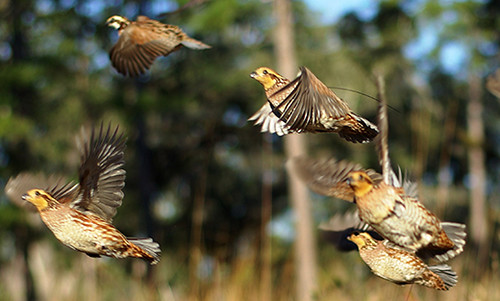
by Rick O'Connor | Dec 13, 2019
‘Bobwhites in Pine Savanna’ Workshop Set
For Jan. 30 in Marianna, Florida
The National Bobwhite Conservation Initiative (NBCI) and partners will host the Tri-State Bobwhite Symposium for professional land managers and landowners Thursday, January 30, 2020, in Marianna, FL.
It is the second Working Lands for Wildlife–Bobwhites in Pine Savanna workshop funded by the Natural Resources Conservation Service and is expected to draw attendees from three states. The program goal is to restore pine savanna on 82,000 acres across seven states using thinning, prescribed fire, and native grass restoration. Federal funding is available to landowners who choose to pursue pine savanna management on that designated landscape.
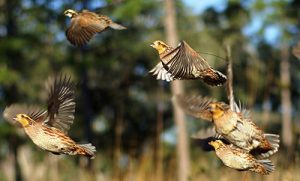
Bobwhite quail are popular with many hunters and management is trying to restore them.
Photo: USDA
“Private lands are a critical and necessary component for landscape-scale restoration of wild bobwhites, which is what NBCI is all about,” said NBCI Forestry Coordinator Steve Chapman. “Active management of pine forests on those lands, while still meeting landowner objectives, is a key NBCI strategy, and 82,000 managed acres will show the dividends of this approach.”
Dr. Jess McGuire, Quail Forever’s Working Lands for Wildlife bobwhite coordinator, added that “in order to achieve this level of restoration, wildlife professionals must be trained in the nuances of bobwhite management.”
The workshop will be from 9am–2pm at the University of Florida, Institute of Food and Agricultural Sciences (UF/IFAS) office, located at 2741 Penn Avenue, Suite 3, Marianna, FL 32448. Preregistration by January 23 is required by contacting jmcguire@quailforever.org or online at http://bit.ly/tristatequail.
Additional partners include Quail Forever, Florida Fish and Wildlife Conservation Commission, Tall Timbers Research Station and Land Conservancy, University of Florida Extension, and the Natural Resources Conservation Service.
Through multiple agreements, NBCI, in collaboration with Quail Forever and Warnell School of Forestry and Natural Resources/University of Georgia, will provide at least one of these workshops in each of the seven states identified in the project geography. Those states include Alabama, Florida, Georgia, New Jersey, North Carolina, South Carolina, and Virginia. Partners will also produce educational materials detailing management techniques and the results of intentional, targeted pine savanna management for bobwhites as part of the overall project.
About NBCI
Headquartered at the University of Tennessee’s Institute of Agriculture/Department of Forestry, Wildlife and Fisheries, NBCI is a science and habitat-based initiative of the National Bobwhite Technical Committee (NBTC) to elevate bobwhite quail recovery from an individual state-by-state proposition to a coordinated, range-wide leadership endeavor to restore wild bobwhites on a landscape scale. The committee is comprised of representatives of 25 state wildlife agencies, various academic research institutions and private conservation organizations. Support for NBCI is provided by the Federal Aid in Wildlife Restoration Program, state wildlife agencies, the Joe Crafton Family Endowment for Quail Initiatives, the University of Tennessee, Park Cities Quail and Roundstone Native Seed.
Contact:
John Doty
Communications Director
(865) 974-7281
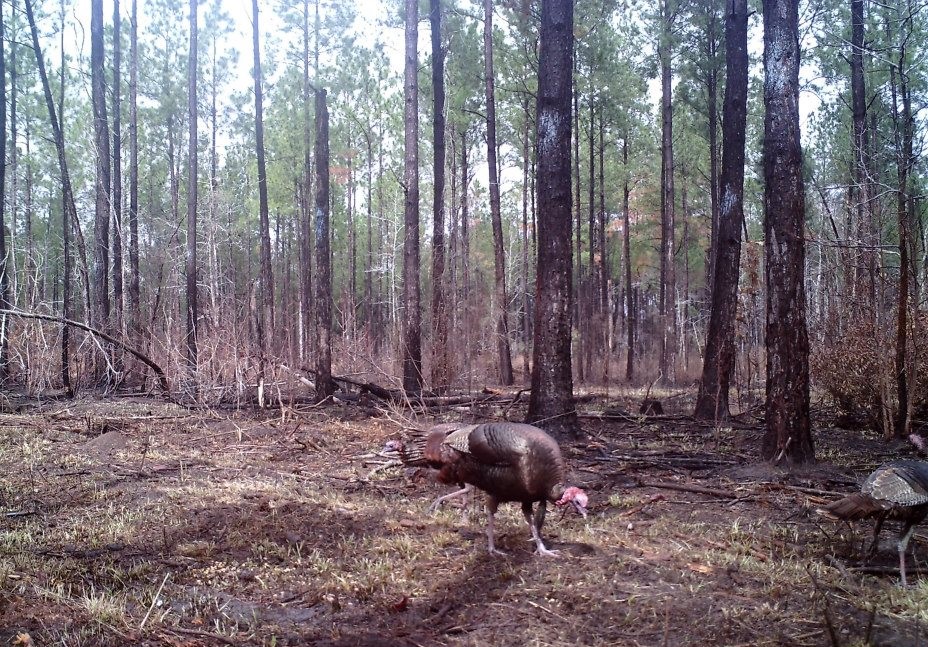
by Shep Eubanks | Nov 14, 2019
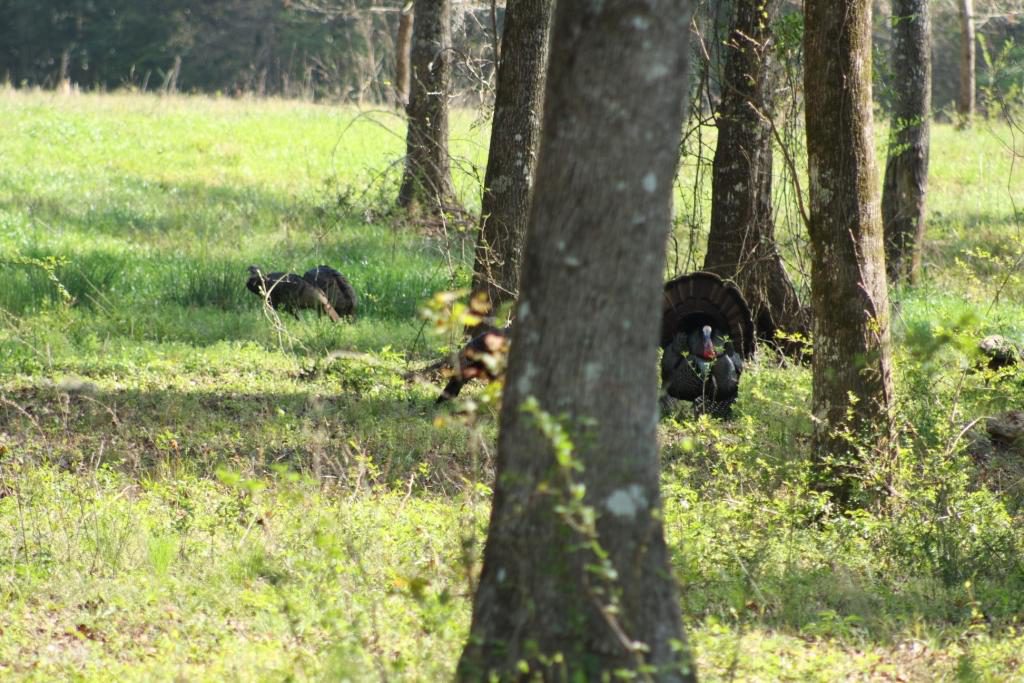
Eastern Wild Turkey Gobbler in Gadsden County – photo by Shep Eubanks UF/IFAS
The above picture of a strutting Eastern Wild Turkey is a sight that many hunters look forward to seeing every spring here in the panhandle of Florida. In order to manage wild turkeys and their habitat it is good to understand some basic facts about their biology.
Wild turkeys are considered a generalist species, meaning that they can eat a wide variety of foods, primarily seeds, insects, and vegetation. They prefer relatively open ground cover so that they can see well and easily move through their surroundings, but they aren’t picky about where they live as long as it provides them year-round groceries and safety. They are also a very adaptable species. Turkeys prefer low, moderately open herbaceous vegetation (less than three feet in height) that they can see through, or see over, and through which they can easily move in relatively close proximity to forested cover. Such open habitat conditions help them see and avoid predators and these areas will typically provide sufficient food in terms of edible plants, fruit, seeds, and insects.
Wild turkeys are considered, ecologically, to be a “prey species” and have evolved as a common food source for numerous animals—seems everything is trying to eat them. Turkey eggs, young (i.e.,poults), and adults are preyed on by such animals as bobcats, raccoons, skunks, opossum, fox , coyotes, armadillos, crows, owls, hawks, bald eagles, and a variety of snakes. Being prey to so many different animals has shaped the turkey’s biology and behavior. Turkeys experience high mortality rates and don’t live very long, on average, <2 years. They are particularly vulnerable during nesting and immediately after hatching. Because of this high mortality, reproduction is really important for turkey populations to replace the individuals that don’t survive from year to year. Wild turkeys have adapted to being a prey species in part, though, by having a high reproductive potential. Hens have the capacity to lay large clutches of eggs. If a nest is destroyed or disturbed, especially during the egg laying or early incubation period, the hen will often re-nest. Turkeys are also polygamous, with males capable of breeding multiple females, which further boosts their reproductive potential.
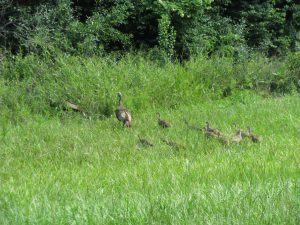
Turkey hen with poults foraging in a grassy field in Gadsden County – photo by Shep Eubanks UF/IFAS
Newly hatched turkeys, referred to as poults, need grassy, open areas so they can find an abundance of insects. Such areas are usually the most critical, and often the most lacking habitat in Florida. Under ideal conditions for turkeys, grassy openings would occupy approximately 25 percent of a turkey’s home range. Additionally, it is of equal importance to have such openings scattered throughout an area, varying in size from 1 to 20 acres such that they are small, or irregular in shape, to maximize the amount of adjacent escape cover (moderately dense vegetation or forested areas that can provide concealment from predators or other disturbances). Large, expansive openings (e.g., large pastures) without any escape cover are not as useful for turkeys since they generally will not venture more than 100 yards away from suitable cover.
Good habitat allows turkeys to SEE approaching danger and to MOVE unimpeded (either to move away from danger or simply to move freely while foraging without risk of ambush). In other words, good habitat provides the right vegetative structure. When thinking about habitat for turkeys, it’s good to always think from a turkey’s point of view….about 3 feet off the ground! Turkeys like open areas where they can see well and easily move.
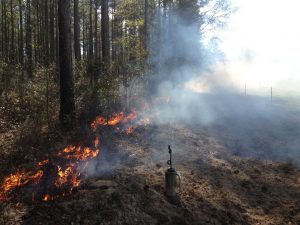
Burning pine land in Gadsden County to improve wild turkey habitat – photo by Shep Eubanks UF/IFAS
One of the best management techniques to manage vegetation structure and composition is prescribed fire. Fire can be very destructive, but if properly applied, fire can be quite beneficial to wildlife and is one of the best things you can do for wild turkeys. When applied correctly, fire has many benefits. Some of the benefits of fire to turkeys and other wildlife include: control of hardwood by setting back woody shrubs and trees in the under story; improving vegetation height and structure; stimulating new herbaceous growth at ground level; stimulating flowering and increased fruit production in some plants; it improves nutritional value and increases palatability of vegetation. All of this leads to increased insect abundance and fewer parasites in the environment. Prescribed fire also has benefits for the landowner. Applied properly and regularly, prescribed fire will reduce risk of catastrophic wildfire which can destroy a timber stand. It reduces hardwood competition so favored pines grow faster and healthier; and reduces the risk of disease, particularly after a thinning or timber cut, by removing logging debris that would otherwise attract insects and disease-causing agents. It can also help control invasive species, and best of all it’s the least expensive option on a cost per acre basis.
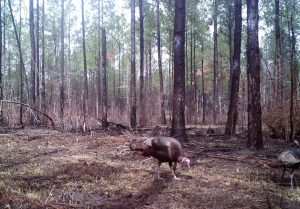
Gobblers in pine stand after burn – Game Camera photo by Shep Eubanks
Another good practice is simply mowing or bush-hogging. Even in areas that aren’t super thick (such as around forest and field edges, or seasonal wetlands), mowing and bush-hogging alone, even without fire, are beneficial as they have much the same effect on the habitat as fire. Basically, you’re removing grown up vegetation and allowing light to reach the ground again. Within pine plantations, roads often provide some of the best, or only, turkey habitat simply because the surrounding vegetation becomes too dense so roads are used for feeding and moving throughout the area. In this regard, wide roads increase the amount of open habitat which provides lots of insects, seeds, and edible vegetation. They also reduce the opportunity for predators to ambush turkeys which can readily occur on narrow roads. Having wide roads is a good land management practice that lets roads dry-out quicker so that they can hold up to traffic better.
If you have pine dominated timber stands on your property, proper thinning is not only good for turkeys, but it’s good for your stand. Young pine stands, particularly those in sapling or early pole stages, are often too thick for wild turkeys, except as escape cover. They get so dense that they shade out everything underneath. They may produce some pine seeds when they get older, but for most of the year, there’s nothing to eat and nothing to attract turkeys to the area. For turkeys, thinning opens up the canopy and allows sunlight to reach the forest floor, which in turn stimulates plant growth of grasses, forbs and soft-mast producing shrubs.
If you have an interest in turkeys, do most management activities outside of the nesting season, which generally runs from the middle of March through June. From a practical standpoint that is not always possible, so on the positive side, if a nest is destroyed (whether by predators or management efforts), a hen will quite often re-nest. Also, the overall importance of management will often outweigh the loss of 1 or 2 nests. The time that turkey nests are at a premium is when a turkey population is low or just trying to get established into an area. In such cases every nest is valuable.
For more information consult with your local Extension Agent .
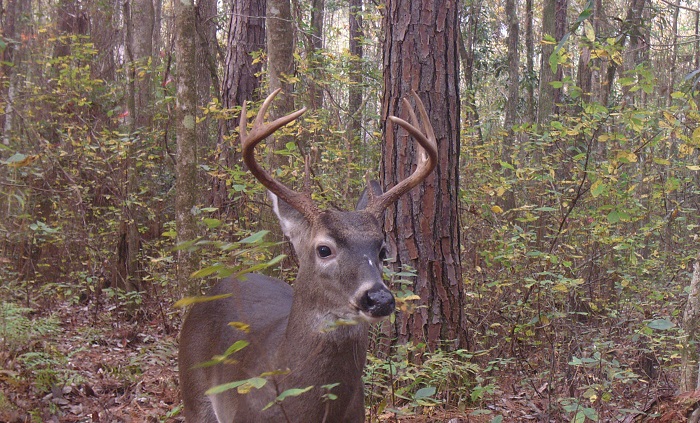
by Mark Mauldin | Nov 8, 2019

There are new regulations this season involving mandatory reporting of all deer harvested in Florida.
Photo Credit: Mark Mauldin
Deer hunting season here in Northwest Florida officially started this past Saturday (10/26) with the opening of archery and crossbow season; muzzleloading and general gun season will both open later this month. If you are fortunate enough to find success hunting in the woods, it is important that you remember substantial changes have gone into effect regarding the mandatory reporting of harvested deer. The following is a only a summary of some of the new regulations – complete official hunting regulations are available from the Florida Fish and Wildlife Conservation Commission.
The primary new regulation, put as simply as possible (again, this is only a summary):
All hunters must log their harvested deer prior to moving it from the point of harvest and report their harvested deer within 24 hours.
A hunter may log a harvested deer on a paper 2019-2020 Deer Harvest Log or via the FWC Deer Harvest Reporting App. The app allows a hunter to log and report a harvested deer, completing the process. If a hunter logs a deer on the paper form, they must also report the deer by calling 844-392-DEER (3337) between 8 a.m. – 8 p.m. ET or reporting online at MyFWC.com/HarvestReport. When successfully completed, either of these options, calling or going online, will result in a confirmation number. The confirmation number must be recorded on the Deer Harvest Log for the process to be complete. Note: using the app also generates a confirmation number that is automatically saved in the “sent” folder within the app. Follow the link for step-by-step instructions for using the FWC Deer Harvest Reporting App.
-
All harvested deer must be logged (on paper form or with the app) prior to being moved from where they were originally found.
-
All harvested deer must be reported (phone, online, or app) and confirmation number recorded on the paper log (or automatically on the app) within 24 hours of harvest**.
**Hunters must report harvested deer: 1) within 24 hours of harvest, or 2) prior to final processing of the deer, or 3) prior to the deer or any parts of the deer being transferred to a meat processor or taxidermist, or 4) prior to the deer leaving the state, whichever occurs first.
Hunters should be prepared to log and report harvested deer before they go hunting. They should have a copy of the 2019-2020 Deer Harvest Log with them, or have the FWC Deer Harvest Reporting App installed on their mobile device. In order to successfully log and report a harvested deer the hunter will also need the following information:
- Name (first and last name of the person who harvested the deer)
- Date of birth
- FWC Customer ID number (CID)
- Date of harvest
- Time of harvest
- Public or private land
- County
- Deer management unit
- Wildlife management area (if applicable)
- Method of harvest
- Antlered or antlerless deer
- Number of antler points (if antlered deer was indicated)
- Antlerless male or female (if antlerless deer was indicated)
- For deer taken on private lands, whether a deer program permit was used (Antlerless Deer Program permit or Private Lands Deer Management Program permit)
- 6-digit Tag number (if a deer program permit was used)
Another change for this hunting season is the establishment of the annual statewide bag limit of 5 deer per person of which no more than 2 deer can be antlerless.

FWC Deer Harvest Reporting APP
https://myfwc.com/hunting/deer/harvest-report/?redirect=harvestreport

FWC Deer Harvest Reporting Log
https://myfwc.com/media/21998/deer-harvest-log.pdf
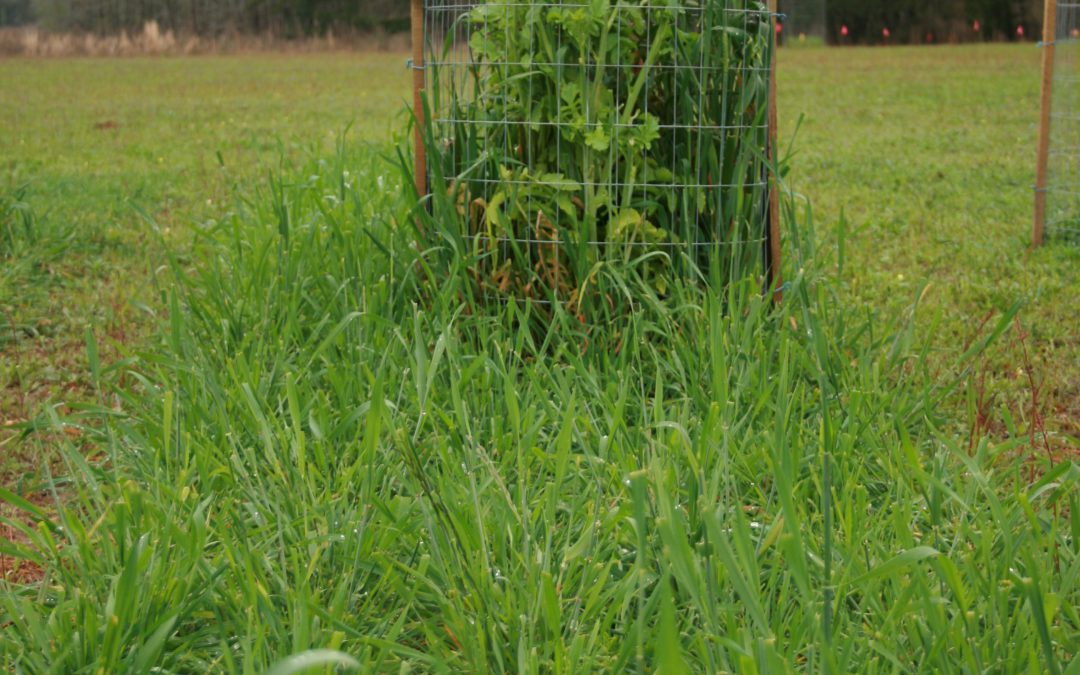
by Jennifer Bearden | Nov 8, 2019
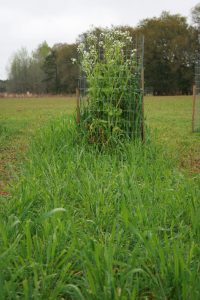
Daikon Radish and Buck Forage Oats Plot
When people put in food plots and are not successful, I normally see the following three problems as possible cause. First, they didn’t consider soil pH or fertility. Second, they didn’t choose the right plant varieties for our area. Third, they didn’t manage weeds properly or at all. So following these three steps can help establish a successful food plot.
- Soil pH and fertility
Often wildlife enthusiasts ignore soil pH and fertility. If the soil pH isn’t right, fertilization is a waste of time and money. Different plants have different needs. Some plants need more phosphorus than others. Some need more iron or zinc or copper. The availability of these elements not only depends on whether they are present in the soil but also on the soil pH. Test, Don’t Guess! It takes a week or two to get the full soil sample results back and costs only $10 per sample. That’s a pretty cheap investment to insure a successful food plot.
- Variety selection
Cool season food plots are generally used as attractants for hunters. It does provide some nutrition for the wildlife as well. The goal is to select forages that are desirable to the animals as well as varieties that grow well in our area. Some great choices include: oats, triticale, clovers, daikon radish and Austrian winter peas. We recommend a blend because it extends the length of time that forages are available to the animals as well as decreased risk of food plot failure. For a more information on recommended cool season forages, go to https://edis.ifas.ufl.edu/ag139.
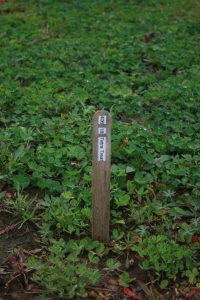
Tetra Treat Clover Mixture Plot
- Weed management
Often tilling the food plot prior to planting is enough to manage most weeds. This is okay when you have native weeds on relatively flat land. If erosion is an issue, or if more problematic weeds such as cogongrass are present, a different weed management strategy is recommended. Glyphosate is a good choice as it is a broad spectrum herbicide that will not negatively affect the food plot. Spray the area with glyphosate 3-4 weeks prior to planting to give it time to kill the weeds. Also, remember that many herbicides are not effective during droughts, so you either need to wait until we have rainfall or work with your extension agent to find a solution that will work for your situation.
These three steps are crucial to successful food plots. First, get your soil pH right and then fertilize properly. Next, choose the right forages and varieties to plant. Then control the weeds so they don’t choke out your food plots. The next step is to enjoy this hunting season. For more information on wildlife food plots, you can contact your local county extension agent.
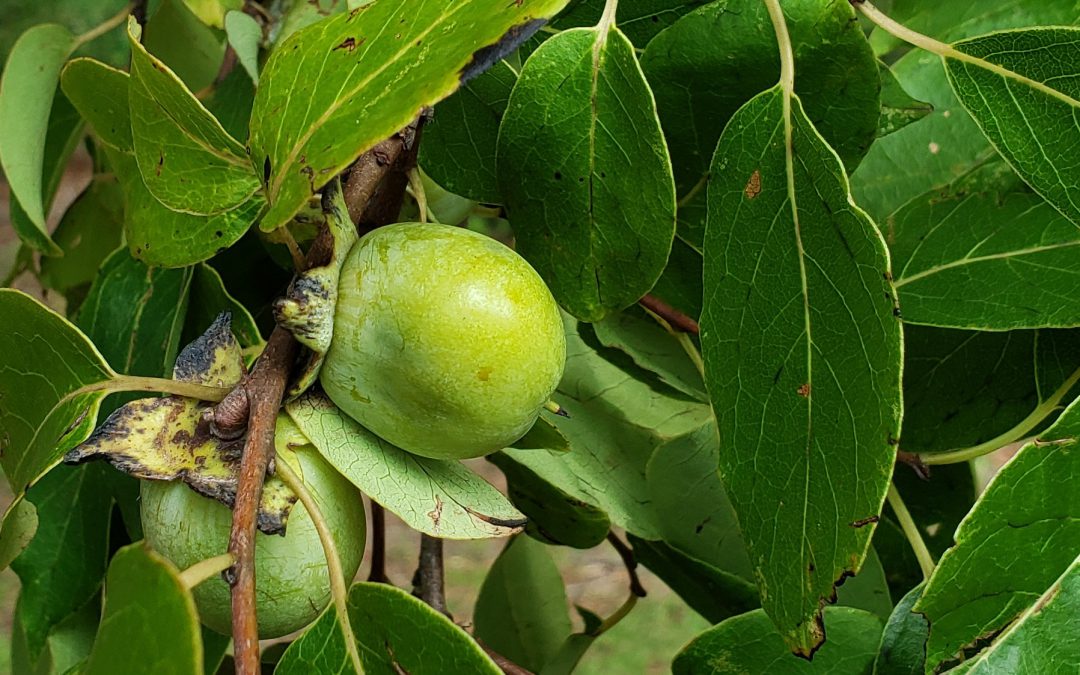
by Mark Mauldin | Oct 10, 2019
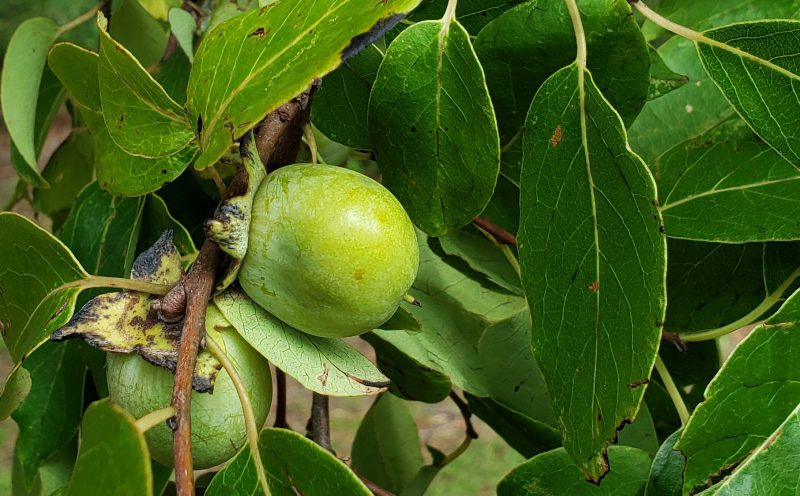
Protecting and promoting plants that produce soft mast, like this wild persimmon, can be a crucial step in improving wildlife habitat. Note: This time of year persimmons will be orange, the picture was taken earlier in the summer.
Photo Credit: Mark Mauldin
Landowners frequently prioritize wildlife abundance and diversity in their management goals. This is often related to a desired recreational activity (hunting, bird watching, etc.).
In order to successfully meet wildlife related management goals, landowners need to understand that animals frequent specific areas based largely on the quantity, quality and diversity of the food and cover resources available. Implementing management strategies that improve wildlife habitat will lead to greater wildlife abundance and diversity.
Herbivorous wildlife feed on plants, mostly in the form of forages and mast crops. All wildlife species have preferences in terms of habitat, especially food sources. Identifying these preferences and managing habitat to meet them will promote the abundance of the desired species.
Herbaceous plants, leaves, buds, etc. – serve as forages for many wildlife species. Promoting their growth and diversity is essential for improving wildlife habitat. Three common habitat management practices that promote forage growth include:
1) Create forest openings and edges; forested areas with multiple species and/or stand ages, areas left unforested allowing for increased herbaceous plant growth.
2) Thinning; open forest canopy allowing more light to hit the ground increasing herbaceous plant growth and diversity.
3) Prescribed fire; recycle nutrients, greatly improve the nutritional quality of herbage and browse, suppress woody understory growth.
Mast – the seeds and fruits of trees and shrubs – is often one of the most important wildlife food sources on a property.
Hard mast includes shelled seeds, like acorns and hickory nuts and is generally produced in the fall and serves as a wildlife food source during the winter.
Soft mast includes fruits, like blackberries and persimmons, and is generally produced in the warmer months, providing vital nutrition when wildlife species are reproducing and/or migrating.
Making management decisions that protect and promote mast producing trees will encourage wildlife populations.
Landowners can make supplemental plantings to increase the quantity and quality of the nutrition available to wildlife. These supplemental plantings (food plots/forage crops and mast producing trees) can be quite expensive and should be well planned to help maximize the return on investment.
Key points to remember to help ensure the success of supplemental wildlife plantings.
- Select species/varieties that are well adapted to the site.
- Take soil samples and make recommended soil amendments prior to planting.
- Make plantings in areas already frequented by wildlife (edges, openings, etc.).
- Food plots should be between 1 and 5 acres. Long, narrow designs that maximize proximity to cover are generally more effective.
Habitat management and other wildlife related topics are being featured this year in the UF/IFAS building at the Sunbelt Ag Expo. Make plans to attend “North America’s Premiere Farm Show” and stop by the UF/IFAS building, get some peanuts and orange juice and learn more about Florida’s Wildlife.
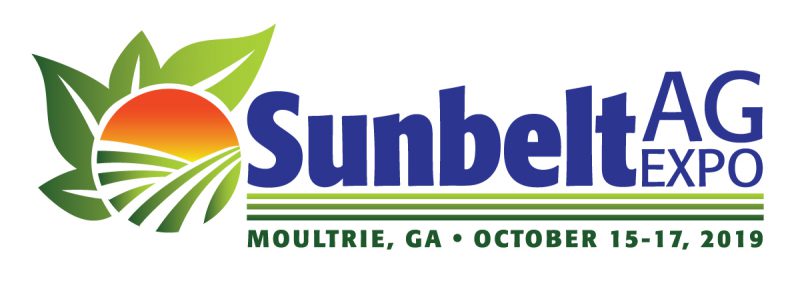 If you have any questions about the topics mentioned above, contact your county’s UF/IFAS Extension Office or check out the additional articles listed on the page linked below.
If you have any questions about the topics mentioned above, contact your county’s UF/IFAS Extension Office or check out the additional articles listed on the page linked below.
EDIS – Wildlife Forages
A significant portion of this article was summarized from Establishing and Maintaining Wildlife Food Sources by Chris Demers et al.






















